François Boucher Biography
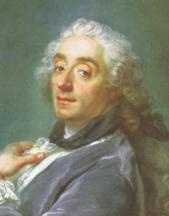
François Boucher was born in the autumn of 1703, Rue de la Verrerie, 11th district of Paris, into the family of a modest painter and designer, Nicolas.
From his father Boucher received a broad artistic training and education, however Nicolas soon realized that his son would need the supervision of a more skilled artist to fully master his talents. Thus in 1720, when Boucher turned seventeen, he entered the studio of François Lemoyne, a rising figure in art and soon to be a lead promoter of the Rococo genre. However, after only a handful of months Boucher decided that Lemoyne was a poor teacher and left the studio.
He found work almost immediately in the workshop of Jean-François Cars, whom he found through an acquaintance. Cars ran an engraving business, and the young Boucher was soon preoccupied with a wide variety of tasks such as designing frontispieces, coats of arms and communion cards. It was through his work at the workshop that Boucher received his first major commission from Jean de Julienne, a friend of the artist Antoine Watteau. Julienne was so impressed with Boucher’s talents that he hired him to assist with the engraving of 125 of Watteau’s most famous drawings. Despite this workload, however, Boucher still managed to devote much time to painting, and in 1723 secured the coveted Prix de Rome, winning him a place in the Académie de France in Rome.
Unfortunately for Boucher, at this time the Academy was either unable or reluctant to finance his trip, and he did not depart Paris until 1727. Information on his stay in Italy is limited, although it’s noted that Boucher was somewhat unimpressed by both the country and the Académie. It is speculated that Boucher was more interested in the career prospects his being a student at the Académie de France would bring him than anything else.
By 1731 his term at the school had ended and he was back in Paris and hard at work trying to gain admittance to the Academy. Three years hence he succeeded after his Rinaldo and Armida (1734) was accepted as his entry piece.
In 1733 Boucher married what was essentially to become his chief model, seventeen-year-old Marie-Jeanne Buseau. Although the couple had three children and remained on good terms throughout their lives together, there were frequent infidelities on both sides.
Boucher’s fame skyrocketed when the Salon reopened in 1737 and he submitted his Four Seasons pastorals (signed 1755), which gained him universal recognition and invited a flow of commissions. Sadly, this was also the year that Boucher’s first teacher, Lemoyne, committed suicide after the death of his wife.
For the next two decades Boucher enjoyed an interval of constant success as his work, be it paintings, tapestries or interior décor, was in high demand from aristocratic and royal patrons. Arguably the most prominent of these was Madame de Pompadour, who, as mistress of the French King since 1745, commissioned a plethora of artistic projects from Boucher. The most famous of his surviving works done for his patroness is a series of portraits, among these Portrait of Madame de Pompadour (1756), Portrait of Marquise de Pompadour (1758) and Portrait of Marquise de Pompadour (1759).
In 1752 Boucher managed to fulfill his ambition of acquiring his own studio at the Louvre. At this point in time he was faced with such an overwhelming amount of work and commissions that he was obliged to hire assistants. Unfortunately, his three favorite students were neither able to help nor succeed him. His son lacked the talent of his father, and his two sons-in-law, Baudouin and Deshays, both died young before their potential could be realized.
By this time Boucher was past his peak. A new shift in taste towards Neo-Classicism, championed by Diderot, brought with it a wave of criticism for the Rococo style, with Boucher naturally becoming the prime target of this movement. To make matters worse, by the mid-50s his eyesight was beginning to fail.
However, Boucher never conformed to Neo-Classicism and continued to draw in the style that had won him fame despite increasingly harsh condemnation from critics. His work was still so high in demand that he was having trouble keeping up with commissions. In addition to this, he succeeded Jean-Baptiste Oudry as director of the Gobelins tapestry factory in 1755. Even after the death of his chief patroness, Madame de Pompadour, in 1764, Boucher continued to receive royal protection, and a year hence Marquis de Marigny, brother to Madame Pompadour, promoted Boucher into the post of King’s Painter following the death of Carle van Loo. Simultaneously, Boucher took up the now vacant position as Director of the Academy.
Although he was in poor health by this time, Boucher’s productivity was surprisingly unaffected. He continued to paint commissions and exhibit his works at the Salon, much to the fury of Diderot. However, even Diderot was obliged to acknowledge the unabated commitment and energy of the old artist after his last exhibition at the Salon in 1769, at which point Boucher was in such bad shape that he was forced to refuse the offer of being an honorary associate member of the Academy of St. Petersburg.
Boucher died a year later on May 30 1770 in his studio at the Louvre.
Bibliography
Boucher by David Wakefield. Chaucer Press, 2006.
Drawings of Francois Boucher by Editors of Scala Publishers. Scala Publishers, 2006.
Francois Boucher, 1703-1770 by Alastair Laing. Harry N Abrams, 1986.
Making Up the Rococo: François Boucher and His Critics by Melissa Hyde. Getty Publications, 2006.
Francois Boucher: Seductive Visions by Jo Hedley. Paul Holberton Publishing, 2007.
Rethinking Boucher by Melissa Hyde, Mark Ledbury. Getty Publications, 2006.
Great Artists of the Western World: The French Rococo: Antoine Watteau, J.B.S. Chardin, Francois Boucher, J.H. Fragonard by Clive; Lyon, Sue, Gregory. Marshall Cavendish, 1990.
- Renaud Et Armide.
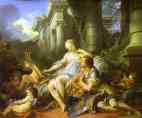
1734. Oil on canvas. 135.5 x 170.5 cm. Louvre, Paris, France. Read Note.
- Madame De Pompadour Standing At Her Dressing Table.
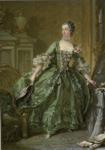
c.1750. Oil on canvas. 62.5 x 46 cm. Waddesdon Manor, The Rothschield Collection, Waddesdon, Buckinghamshire, UK. Read Note.
- Portrait Of Madame De Pompadour.
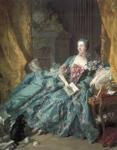
1756. Oil on canvas. 201 x 157. Alte Pinakothek, Munich, Germany. Read Note.
- Portrait Of The Marquise De Pompadour.
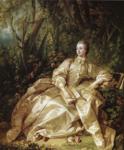
1758. 72.3 x 57.1 cm. Victoria & Albert Museum, London, UK. Read Note.
- Portrait Of The Marquise De Pompadour.
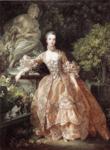
1759. 91 x 69 cm. Wallace Collection, London, UK. Read Note.